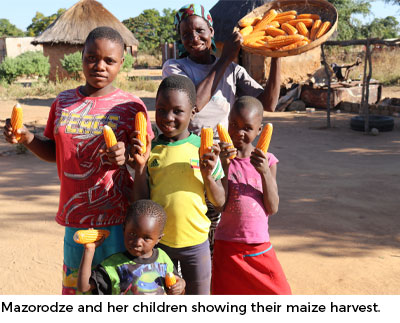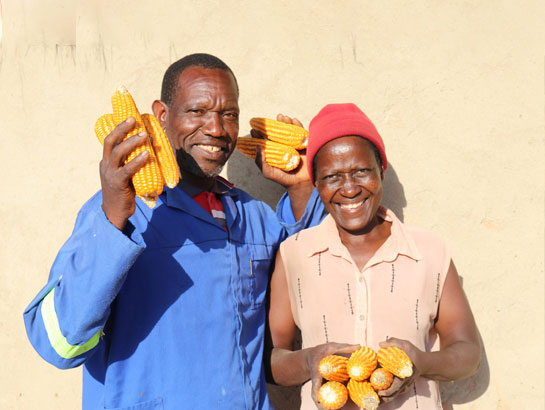Austin Mhembere and his wife Nyarai are residents of Goredema village in the Mazowe district of Zimbabwe’s Mashonaland Central province. Austin`s journey into vitamin A maize production began with a training session from HarvestPlus. Convinced that this biofortified orange-colored maize was a nutritious alternative to white maize, Austin made a decision to ensure that his family grew vitamin A maize (VAM) on a 0.1 hectare plot, and he has since increased his acreage to 0.5 hectares. Austin has never looked back.
“Since I started growing orange maize, I feel very proud because I am growing and feeding my family healthy and nutritious food. My family enjoys the sadza and other various products made from orange maize like mahewu, porridge, samp, and chimodho,” said Austin.
In 2017, the Zimbabwe Livelihoods and Food Security Programme (LFSP) introduced Austin and other farmers from Mazowe and Zvimba districts to biofortified crops and other business opportunities in biofortified crop production.
The LFSP is a six-year program managed by the Food and Agriculture Organization of the United Nations (FAO) and Palladium, and funded by the UK Government’s Department for International Development (UKAid). HarvestPlus is the program’s technical partner on biofortification.
The program aims to improve food, nutrition, and income security among smallholder farming households through promoting the production and consumption of diverse nutrient-dense crops, including biofortified crops. The VAM varieties distributed by LFSP were developed and released in the country by the Department of Research and Specialist Services (DR&SS) with support from HarvestPlus through its partnership with the International Maize and Wheat Improvement Center (CIMMYT).
“I grew my first crop of orange maize in the 2017/18 agricultural season, 2 kg on a 0.1 hectare plot. The crop did not grow well at that time due to unfavorable rainfall patterns and I only managed to harvest 150 kg. I was not happy with my harvest and did not grow anything during the 2018/19 season. We however missed eating orange maize so we decided to grow it again in the 2019/20 farming season. I was happy with my decision as our harvest then came out well,” said Austin.
With the interventions from LFSP and technical support from HarvestPlus, Austin is one of about 12,000 farmers who grew VAM during the 2019/20 farming season. Austin received a 10 kg packet of certified VAM seed under a contract-farming arrangement with biofortified food company Sky Brands, and he purchased other inputs such as fertilizer on his own.
Austin planted the seed on his 0.5 hectare plot and produced 2 metric tons (MT) of VAM; this was a much higher maize yield than the average of 0.95 MT maize per hectare among farmers in his community. From their harvest, Austin’s family plans to keep 200 kg for their own consumption and sell the rest. As per the contract, Austin is supposed to sell his grain to Sky Brands, and from the proceeds of the sale, he is expected to pay back USD 25 for the 10 kg seed received.
Austin is one of 422 farmers who participated in the contract farming arrangement with Sky Brands. Fifty percent of these contracted farmers produced enough grain to meet their home consumption needs, sell the surplus and pay back their seed loan, and raise income to meet their other needs.
“My wife and I agreed that we are going to keep 200 kg for our family consumption. It is just the two of us here and 200 kg is enough. We are also going to send a few bags to our children in Harare [Zimbabwe’s capital] because they also get maize for mealie meal from us every year,” said Austin.
Due to a difficult season, not every farmer was as lucky as Austin to have such a good harvest. Some farmers failed to harvest enough grain to last them into the next farming season. Vivian Mazorodze, from a village in Zvimba district, is one such farmer. There was a long dry spell soon after the onset of the rainy season resulting in poor yields and in some cases complete loss of the earlier planted crop.
 “I planted early with the first rains, the crop germinated very well, but suddenly the rains disappeared and the dry conditions persisted, severely affecting my crop,” said Mazorodze.
“I planted early with the first rains, the crop germinated very well, but suddenly the rains disappeared and the dry conditions persisted, severely affecting my crop,” said Mazorodze.
Mazorodze also received 10 kg of seed on contract, which she planted on her 0.5 hectare plot, but only managed to harvest 400 kg of grain. Mazorodze has no intention of selling any of her grain. She plans to consume the maize with her family of five until their next harvest in the 2020/21 farming season.
“I want my children to eat healthy so I have no intentions to sell my grain,” said Mazorodze.
A recent study by the LFSP showed that more than 90 percent of farmers in the 12 LFSP target districts were willing to grow and consume VAM. However, the actual production and consumption of VAM was much lower, with most farmers citing the unavailability of seed as the main reason why they did not grow it.
To counter this challenge, six seed companies are now growing and multiplying orange maize seed for the market. However, Austin and his colleagues in Mazowe district have devised a proactive, community-driven solution to their seed availability challenges. “We hope to form a club, and shall buy the orange maize seed ourselves, and sell some to other farmers within our community. This will ease the hassles of traveling to Glendale or Bindura town to buy seed. Transport is now scarce and very expensive so farmers cannot afford to go far in search of seed,” said Austin.
Timely availability and access to seed for farmers has always been a major challenge, worsened by the difficult economic situation that has left many farming families dependent on the government for inputs. Including biofortified maize seed in government input support programs would help farmers to access it.
The VAM that Austin, Mazorodze, and other farmers are growing is indeed a valuable crop for food nutrition security in the family. The biofortified maize provides up to 50 percent of daily vitamin A needs. It is high yielding, disease- and virus-resistant, and drought-tolerant. Vitamin A is important for the development of a healthy immune system, good vision, and fetal development.
“Poor nutrition causes a range of serious and costly health problems, from impaired cognitive and physical development to illness, disease, and death,” explained Fungai Kutyauripo, the HarvestPlus Nutrition Officer in Zimbabwe.
“The implications extend far beyond health outcomes, affecting educational attainment, workforce capacity and productivity, and economic progress. The linkages from nutrition status to long-term well-being are clear, and consequently, stunting prevalence is regarded not only as a measure of long-term malnutrition but a marker for national economic growth,” she added.
